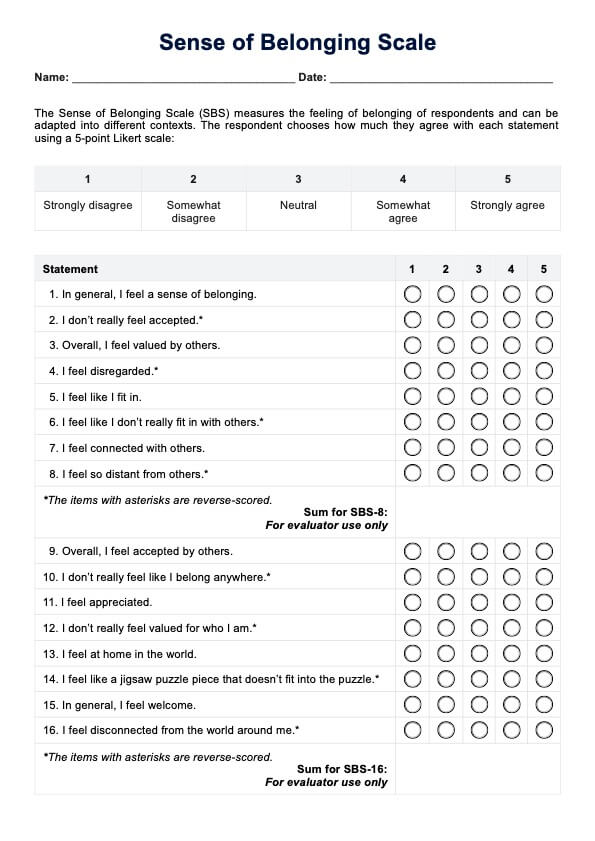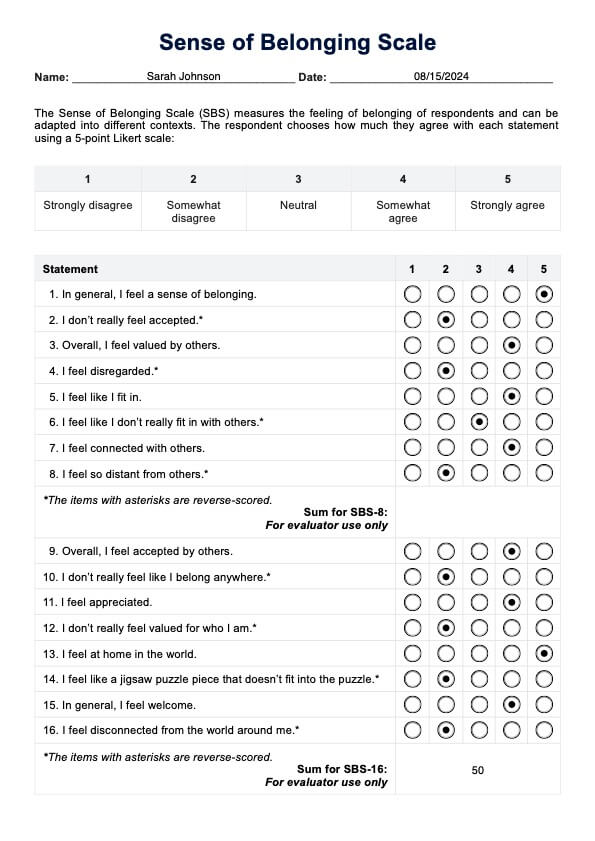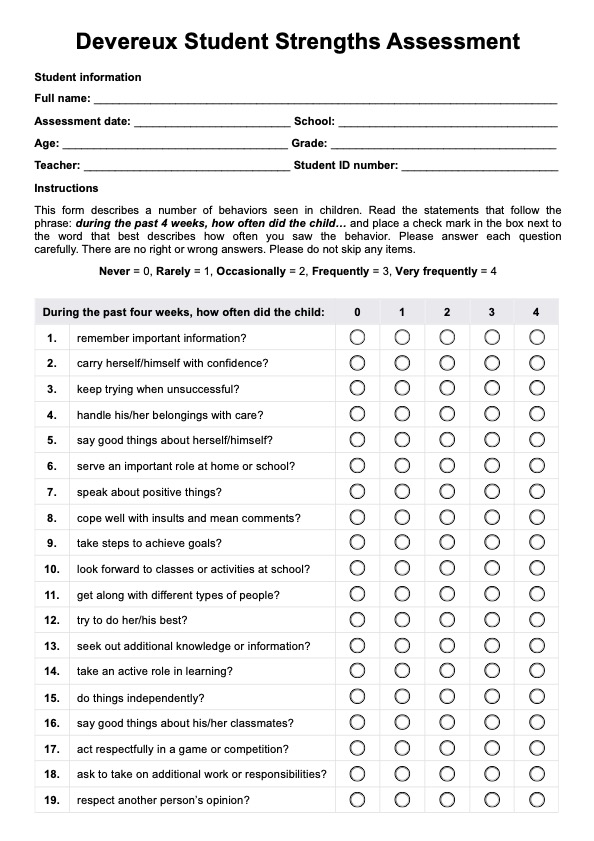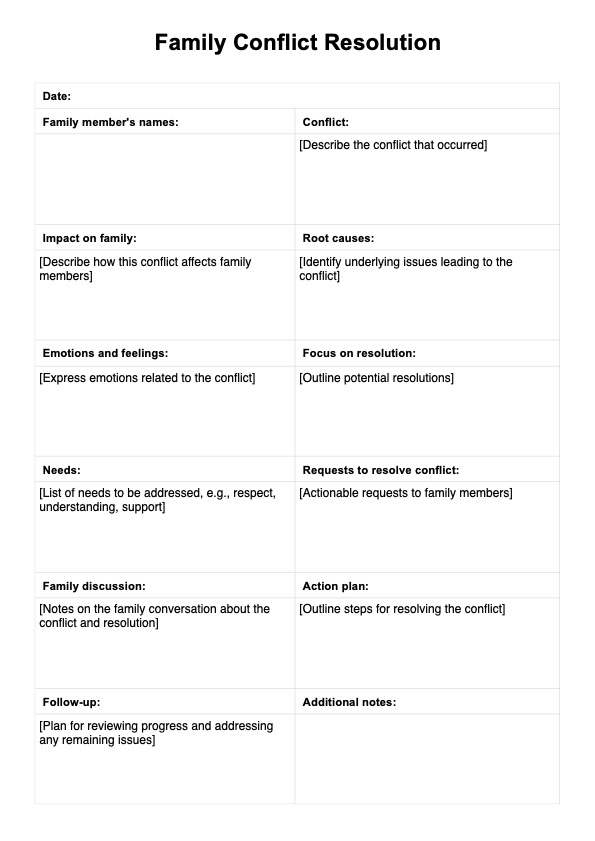Sense of Belonging Scale
The Sense of Belonging Scale is a tool used to measure an individual's feelings of acceptance and inclusion within a group or community. Use our template now.


What is the Sense of Belonging Scale?
A Sense of Belonging Scale is a psychological assessment tool designed to measure an individual's perception of belonging within specific contexts. The scale plays a crucial role in understanding general well-being outcomes, as a strong sense of belonging is closely linked to positive social contact and overall life satisfaction (Hagerty et al., 1992; Mellor et al., 2008).
The importance of belonging has been prompting research for several years due to its role in various psychological theories. As such, various researchers have developed multiple versions of the Sense of Belonging Scale, each tailored to a specific context and timeframe. As such, we have created a template based on a highly adaptable version (Mellinger & Park, 2023) that demonstrated high internal consistency and convergent validity (Mellinger et al., 2023).
The scale contains items that help determine the extent of an individual's inclusion relevant to their environment, including loneliness and belonging—these things are inversely correlated but make independent contributions to general well-being. It evaluates various dimensions, including four well-being measures (Mellinger et al., 2023):
- A sense of being valued
- A sense of being accepted
- A sense of being included/connected
- A sense of fitting into a social environment
The Sense of Belonging Scale can be used alongside other assessments, such as the social connectedness scale and social assurance scales, to provide a comprehensive view of an individual's social integration.
Sense of Belonging Scale Template
Sense of Belonging Scale Example
How to use our Sense of Belonging Scale template
Carepatron's Sense of Belonging Scale template contains the global trait version of Mellinger, Fritzson, Park, and Dimidjian's Sense of Belonging Scale, making it an adaptable and valuable tool for healthcare professionals seeking to assess and enhance their patients' sense of belonging. It contains both the SBS-8 and SBS-16 versions, and you may choose whether to administer the short or the long version.
Below are the steps to effectively use the Sense of Belonging Scale template.
Step 1: Access the scale PDF
Begin by clicking "Use template" to open Carepatron's Sense of Belonging Scale template through the platform. The template is available in a downloadable PDF format, making it easy to print or use digitally. You may also customize it for a specific context (such as belonging in a community or organization) and timeframe (such as the feeling of belonging felt within the past week or year) if you open it in the app.
Step 2: Review the scale
Before introducing the scale to your patients, take a few moments to review the PDF. Familiarize yourself with the questions and structure of the scale, general measures of various aspects of belonging, such as inclusion and valued involvement. Understanding the internal consistency of the scale will help you interpret the results accurately and provide better insights during patient consultations.
Step 3: Use the scale with your patient
Introduce the Sense of Belonging Scale and explain its purpose. They can answer it themselves, but preferable, you will administer it in order to randomize the order of questions. Respondents are asked to rate each statement on a 5-point Likert scale, ranging from "Strongly disagree" (1) to "Strongly agree" (5). Ensure the patient feels comfortable and informed before they begin.
Scoring and interpretation
Scoring the Sense of Belonging Scale involves summing the responses and calculating the mean for a more accurate reflection of the individual's sense of belonging. If you used only the SBS-8 items, divide the sum by 8; if you used the SBS-16, divide the sum by 16.
There are no specified official or standardized cut-off scores for the scale, so researchers may establish their own benchmarks based on normative data or specific research goals. However, a higher average generally indicates a stronger sense of belonging.
Next steps after using the scale
After administering and scoring the Sense of Belonging Scale, carefully analyze the results to identify any areas where the patient may feel a lack of belonging. These insights should be used to guide further conversations with the respondent/s, exploring underlying issues that may contribute to these feelings.
From there, develop an intervention plan to enhance the respondent/s sense of belonging. This plan could include counseling, support groups, or other strategies to improve social-environment connections. Regular follow-ups should be scheduled to monitor progress and adjust the care plan as needed.
Overall, this scale is most useful in evaluating and changing environments to further improve inclusion.
References
Hagerty, B. M. K., Lynch-Sauer, J., Patusky, K. L., Bouwsema, M., & Collier, P. (1992). Sense of belonging: A vital mental health concept. Archives of Psychiatric Nursing, 6(3), 172–177. https://doi.org/10.1016/0883-9417(92)90028-h
Mellinger , C., & Park , B. (2023, November 1). SBS_ANONYMOUS.pdf. OSF; Center for Open Science. https://osf.io/kfcyt
Mellinger, C., Fritzson, A., Park, B., & Dimidjian, S. (2023). Developing the Sense of Belonging Scale and understanding its relationship to loneliness, need to belong, and general well-being outcomes. Journal of Personality Assessment, 106(3), 1–14. https://doi.org/10.1080/00223891.2023.2279564
Mellor, D., Stokes, M., Firth, L., Hayashi, Y., & Cummins, R. (2008). Need for belonging, relationship satisfaction, loneliness, and life satisfaction. Personality and Individual Differences, 45(3), 213–218. https://doi.org/10.1016/j.paid.2008.03.020
Commonly asked questions
The Sense of Belonging Scale is a psychological assessment tool designed to gauge an individual’s perception of belonging within a specific context reported, such as a social group or environment. It evaluates factors like inclusion, valued involvement, and social connectedness to determine the extent of one’s sense of belonging.
Evaluating a sense of belonging involves administering the Sense of Belonging Scale, where individuals rate statements on a 5-point Likert scale. The scores are then analyzed to assess the individual’s overall feeling of inclusion and connection within their environment.
The General Belongingness Scale is a broader assessment tool used to measure an individual’s overall sense of belonging across various contexts. It captures the fundamental need for social connections and the feeling of being part of a community or group.




















-template.jpg)



















































































